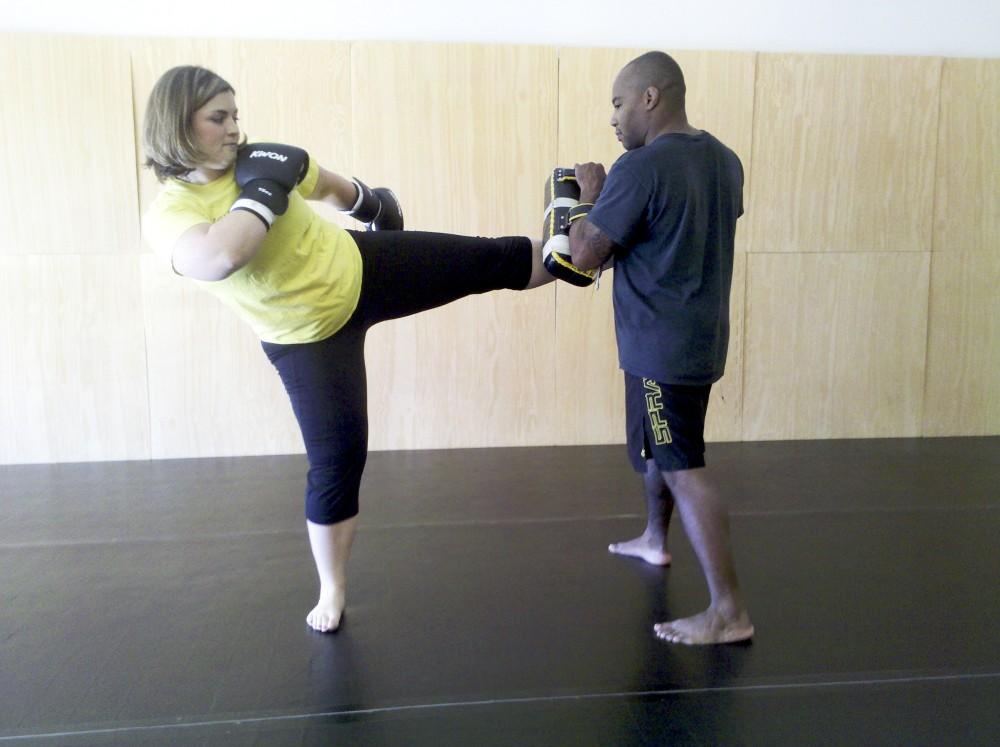Mixed martial arts encourages exercise, teaches discipline to students

Courtesy Photo / Ryan Bow GVSU Philanthropy Professor Nicole Notario-Risk trains with MMA fighter Ryan Bow
Sep 23, 2010
If you answered beer pong, cornhole or even hillbilly horseshoes, you might need to cut back on the alcohol consumption.
The answer is mixed martial arts, more commonly known as MMA.
You might say, “But that’s just brutal, machismo cage fighting!”
Oh, how wrong that is.
Ryan Bow, the current coach at Kaminari Dojo in downtown Grand Rapids, has practiced MMA since he left the country 14 years ago for Japan – alone – at age 17 to study the sport.
“When I left, MMA was still very much illegal on any professional level,” Bow said. “I left to go somewhere where I could learn and grow.”
Pushed by the sudden emergence of the Ultimate Fighting Championship on pay-per-view television, legal MMA events are popping up across the country. The fights provide a significant economic boost wherever they are; according to the Ohio Athletic Commission, a single event in Columbus produced $11 million in external economic activity for the city in 2007.
“MMA is one of the fastest-growing sports in the country right now,” Bow said. “A lot of people misrepresent it as cage fighting. It’s actually learning a form of martial arts. You learn things about making you grow as a person, not just learning to punch people in the head.”
According to the UFC, specific care is put into ensuring the health of every participant. All athletes are given pre- and post-match MRIs. Four ringside doctors and two ambulances are mandatory for every match as well, and steroid testing is more commonplace than in a baseball dugout.
More than just a steel cage death match, MMA workouts draw heavily from jiu-jitsu, judo, karate and wrestling, to name a few.
Senior Kiely Rich has been a part of GVSU’s MMA program since his freshman year and said he joined originally because he wanted a different workout regiment after wrestling all through high school.
“I was drawn to its intensity,” Rich said. “I signed up for it not knowing what to expect, but it’s much more difficult than what you see on television. I didn’t think I would be obsessed with it. I actually thought about quitting during my first month, but I’m glad I stuck with it.”
Rich added he really appreciates the external effects that MMA has had on his personal life.
“Day in and day out, practices are so hard that I compare my daily struggles to it,” Rich said. “Everything I go through in life, I can compare it to what practices are like. It makes everything that much easier.”
Senior Greg Patten, who trains with Rich, said MMA has made him more calm.
“MMA has made me more passive, without a doubt,” he said. “The No. 1 thing we learn is to respect other people. You never know what type of person you’re going to come across. Violence is never the answer. This teaches you from day one about respect: you always bow before the start and shake hands afterward.”
Bow said he first and foremost teaches personal restraint.
“MMA is more than just learning how to fight,” Bow said. “It’s a great way to learn about discipline and self-control, too. You don’t have to fight. You can learn the techniques and use it as a way to stay in shape.”






















